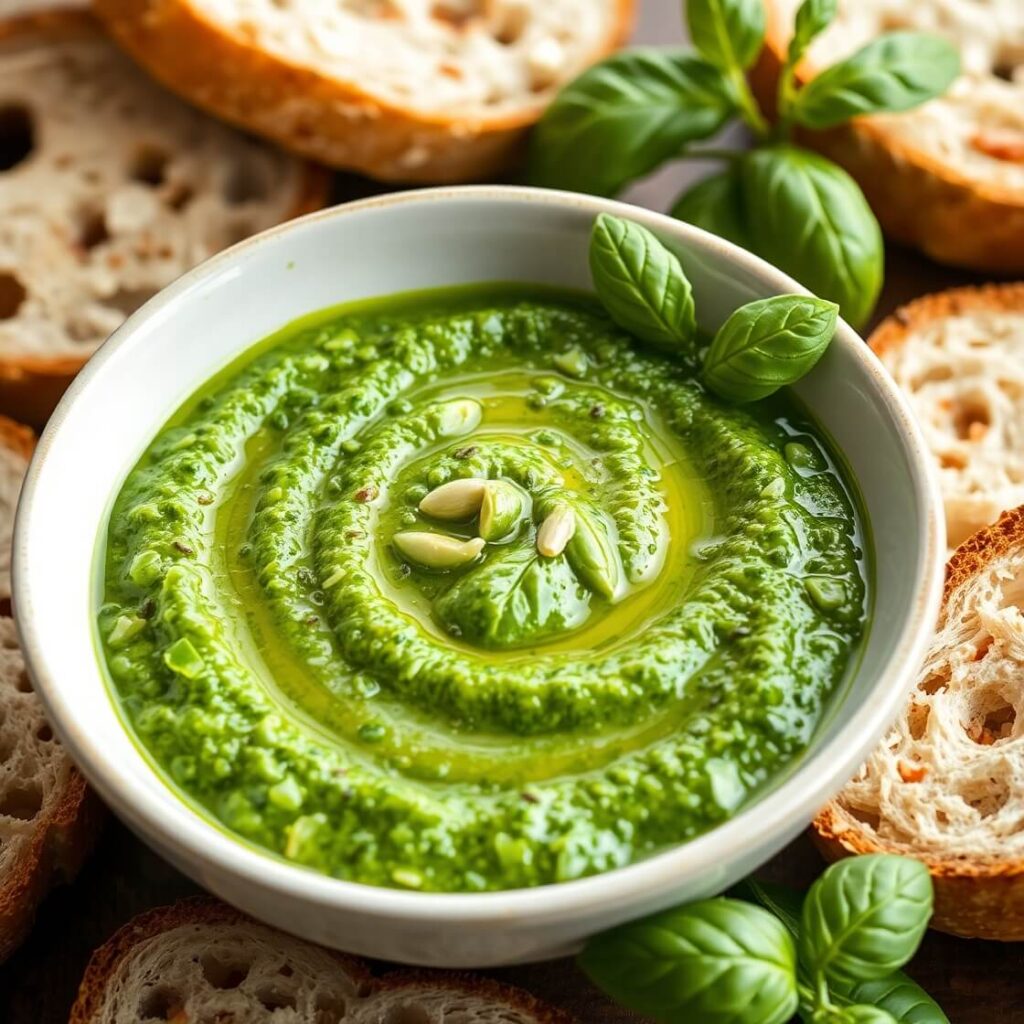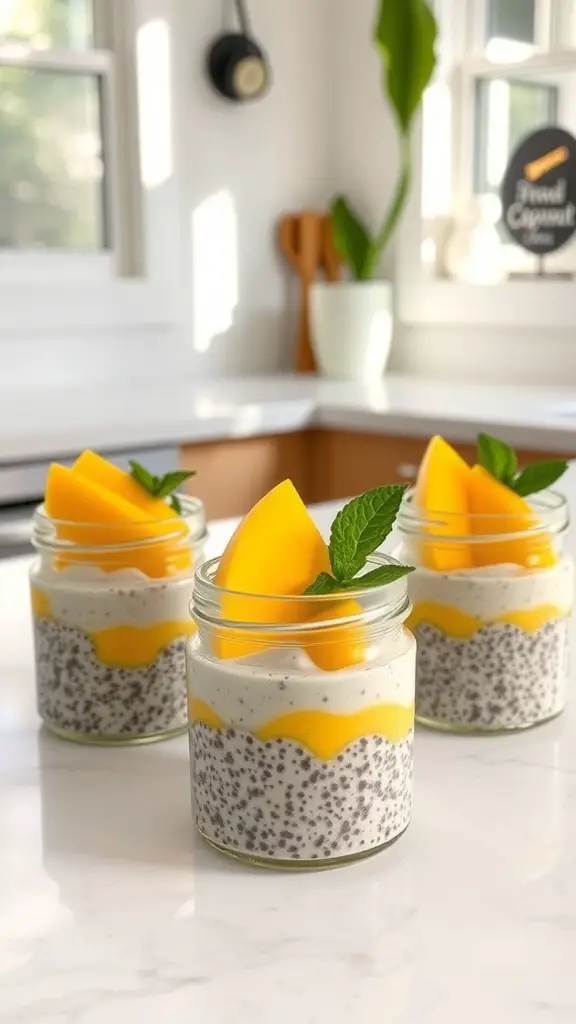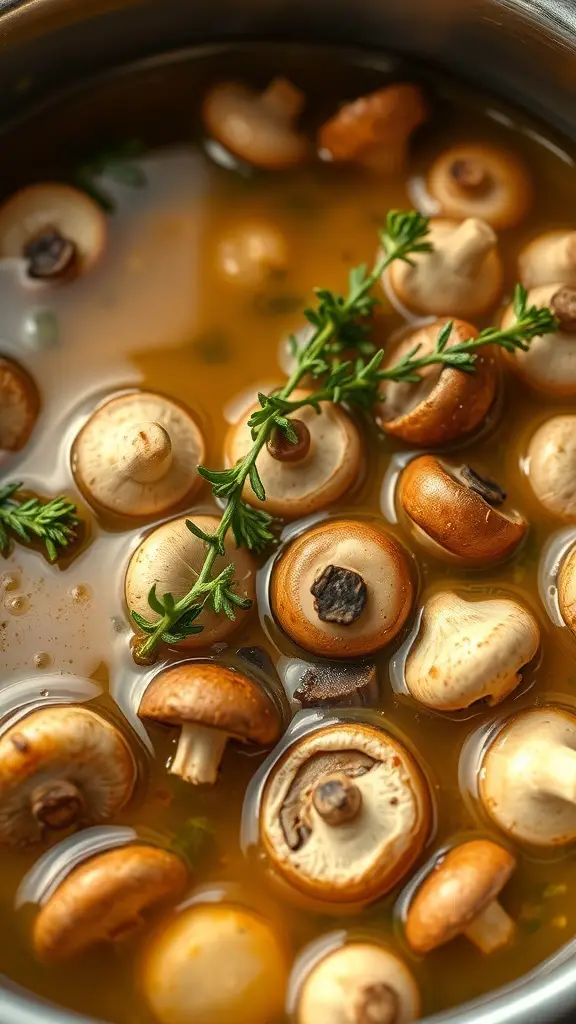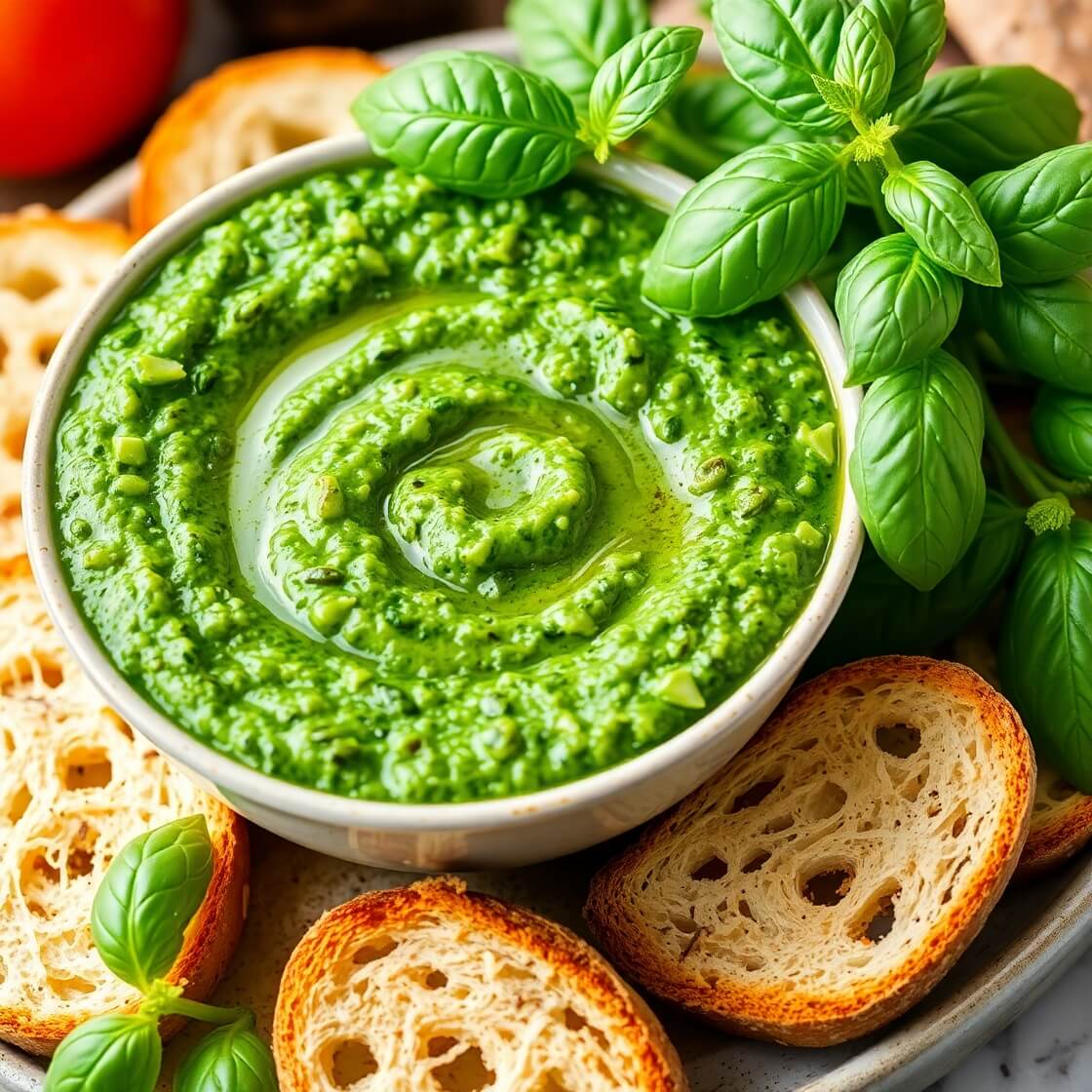
Pesto is one of those timeless sauces that instantly brings a burst of fresh, vibrant flavor to any dish. I decided to create my own homemade pesto recipe because, honestly, nothing beats the taste of fresh basil, garlic, and pine nuts blended together with good-quality olive oil and Parmesan cheese. Store-bought pesto can sometimes feel a bit dull or overly salty, but making it at home allows you to customize every ingredient to your liking.
Plus, it’s incredibly simple and quick to prepare — perfect for those moments when you want to elevate a simple pasta or sandwich into something extraordinary. If you’ve never tried making pesto from scratch, this recipe will guide you through the process with ease and confidence. Trust me, once you taste homemade pesto, you’ll never look back.
Why I Love This Recipe
I love this recipe because it captures the essence of fresh Italian cooking in a jar. The bright aroma of freshly picked basil, the subtle crunch of toasted pine nuts, and the creamy nuttiness of Parmesan come together to create a sauce that’s incredibly versatile and delicious.
People make pesto for many reasons. Some want to bring freshness to their meals, others seek a quick sauce that packs a punch of flavor without fuss. This recipe’s specialty lies in its balance — it’s not too oily, not too salty, and it has just the right amount of garlic to awaken your taste buds without overpowering the basil’s delicate flavor.
What makes it even better is how you can use it — drizzled over pasta, spread on toast, mixed into soups, or even as a marinade. This homemade pesto recipe gives you complete control over the ingredients, ensuring every bite is pure, fresh, and bursting with natural flavors. And that satisfaction of knowing you made it yourself? That’s the icing on the cake.
Ingredients for Homemade Pesto Recipe
To make a truly authentic and fresh pesto, you’ll need a handful of simple ingredients that complement each other perfectly.
First and foremost, fresh basil leaves are the star of the show. Choose vibrant green, tender leaves for the best flavor. Next, you’ll need pine nuts, which add a subtle crunch and nutty richness. Garlic cloves bring a mild sharpness and depth, while freshly grated Parmesan cheese lends a creamy, salty finish.
Good-quality extra virgin olive oil is essential — it’s the glue that binds everything together and gives the pesto its luscious texture. A pinch of salt helps to bring out the flavors, and a little fresh black pepper can add a nice kick.
These ingredients are easy to find in most grocery stores, and each one plays a key role in making your pesto vibrant, fresh, and irresistibly delicious.
How Much Time Will You Need
One of the best things about this homemade pesto recipe is how fast it comes together. From start to finish, you’re looking at about 10 to 15 minutes. Washing and drying the basil leaves takes just a few minutes, and prepping the other ingredients is just as quick.
The actual blending or pulsing in a food processor is usually under 5 minutes. This means you can whip up fresh pesto even on busy weeknights or when unexpected guests arrive. And since it’s so easy, you might find yourself making it often!
How to Make This Homemade Pesto Recipe
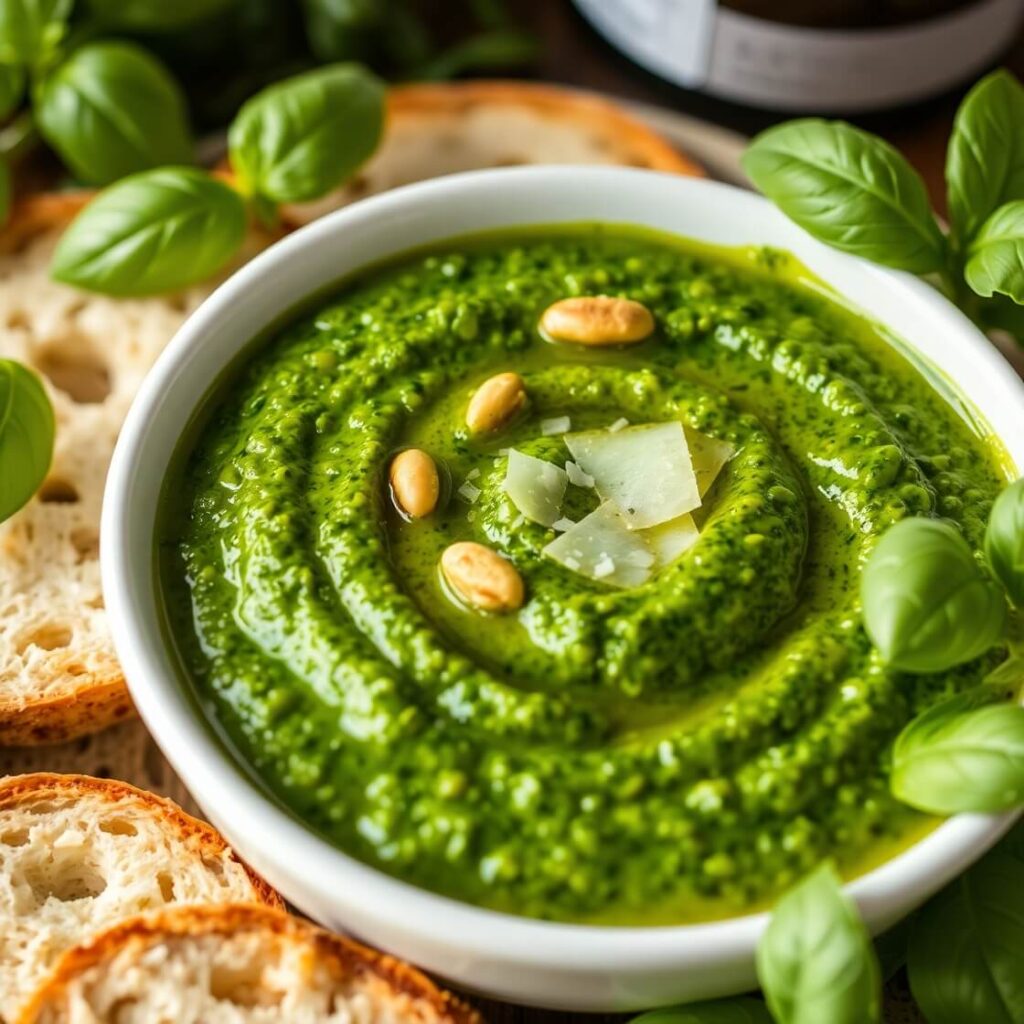
Step – 1: Start by rinsing your fresh basil leaves under cold water to remove any dirt or grit. Gently pat them dry with a clean kitchen towel or use a salad spinner to remove excess moisture. Dry leaves are key to prevent your pesto from becoming watery.
Step – 2: Lightly toast your pine nuts in a dry skillet over medium heat. Keep them moving in the pan until they’re golden and fragrant — this usually takes 2 to 3 minutes. Toasting enhances their nutty flavor and adds depth to your pesto.
Step – 3: In your food processor, combine the basil leaves, toasted pine nuts, and peeled garlic cloves. Pulse a few times until everything is coarsely chopped.
Step – 4: With the processor running, slowly drizzle in the extra virgin olive oil. Continue blending until the mixture is smooth but still has some texture — you want a balance between creamy and slightly chunky.
Step – 5: Add the freshly grated Parmesan cheese, a pinch of salt, and freshly cracked black pepper. Pulse a few more times to incorporate everything evenly.
Step – 6: Taste your pesto and adjust seasoning as needed. You might want a little more cheese for richness or a touch more salt to bring out the flavors.
Step – 7: Transfer the pesto to a clean jar or container. If not using immediately, pour a thin layer of olive oil on top to preserve its vibrant green color and freshness.
Substitutions
While classic pesto is made with basil and pine nuts, you can definitely play around with substitutions to suit your taste or dietary needs.
If pine nuts are hard to find or too expensive, walnuts or almonds make excellent alternatives. They add a slightly different nutty flavor but still provide great texture.
For a dairy-free or vegan version, simply skip the Parmesan cheese or substitute it with nutritional yeast, which adds a cheesy, umami flavor.
If fresh basil is not available, try using fresh spinach or arugula, though the flavor will be milder and less traditional. You can also add lemon juice for extra brightness if you want a tangier pesto.
Garlic can be adjusted or even omitted if you prefer a milder taste. Feel free to experiment and make the pesto your own!
Best Side Dishes of Homemade Pesto Recipe
Pesto pairs wonderfully with a variety of dishes. Here are three of my favorite side options to enjoy alongside pesto-based meals:
- Garlic Bread: The crispy, buttery texture of garlic bread complements the fresh, herbaceous flavor of pesto beautifully.
- Roasted Vegetables: Roasted carrots, zucchini, or bell peppers drizzled with pesto create a flavorful and healthy side.
- Caprese Salad: The combination of fresh tomatoes, mozzarella, and basil pesto is a refreshing and classic accompaniment.
These sides help to enhance the pesto experience, adding texture, balance, and complementary flavors to your meal.
Serving and Presentation Tips
Serving homemade pesto is as much about the visual appeal as it is about taste. To really impress your guests or simply elevate your meal, presentation matters. One great way is to serve the pesto in a small rustic bowl or glass jar with a drizzle of olive oil on top, garnished with a fresh basil leaf or a few toasted pine nuts. This immediately signals freshness and invites you to dig in.
If you’re tossing pesto with pasta, reserve a bit of the pasta cooking water and mix it in to create a silky sauce that clings perfectly to every strand. Serve the pasta on a white or lightly colored plate to let the vibrant green pesto pop. Finish with a sprinkle of extra Parmesan and a few fresh basil leaves. For bruschetta or crostini, spread a generous layer of pesto and top with halved cherry tomatoes or mozzarella balls for a colorful contrast.
Small touches like using a drizzle of high-quality olive oil and freshly cracked black pepper right before serving also enhance the flavor and make your dish look professionally crafted.
Tips and Tricks to Make This Recipe Even Better

Making pesto might seem simple, but there are a few insider tips that will take your sauce from good to extraordinary.
First, always use fresh basil leaves and avoid any that are wilted or yellowed. Freshness makes all the difference in flavor and color.
Don’t skip toasting the pine nuts — this step brings out their natural oils and deepens the flavor profile.
Use a food processor or blender, but pulse in short bursts rather than running it continuously. This helps keep a nice texture instead of turning the pesto into a puree.
If you want a creamier pesto, add a little more olive oil gradually, but don’t overdo it or your sauce will be too runny.
For a brighter flavor, add a squeeze of fresh lemon juice right before serving — it balances the richness perfectly.
Lastly, always taste and adjust the seasoning at the end. Sometimes a pinch more salt or a touch more cheese can make all the difference.
Common Mistakes to Avoid
Making pesto is forgiving, but a few common mistakes can dull the flavor or ruin the texture.
Avoid using pre-grated Parmesan cheese — it doesn’t melt well and lacks the fresh flavor of real cheese.
Don’t overload the food processor. If you add too many ingredients at once, the pesto might not blend evenly.
Skip adding too much garlic. While garlic is essential, too much can overpower the basil and make the sauce bitter.
Be careful with olive oil quality. Using a low-grade oil can give your pesto an unpleasant taste. Always choose a good extra virgin olive oil.
Finally, don’t store pesto uncovered or exposed to air. It oxidizes quickly and turns brown, losing its bright green color and fresh flavor.
How to Store It
If you have leftover pesto, proper storage is key to keeping it fresh and flavorful.
Transfer the pesto to an airtight container and pour a thin layer of olive oil over the surface to create a barrier against air.
Store it in the refrigerator, where it will stay good for up to a week.
For longer storage, pesto freezes wonderfully. Portion it into ice cube trays, freeze, and then transfer the cubes to a freezer bag. This way, you can thaw small amounts as needed.
Avoid freezing pesto with cheese if possible — it can alter the texture, but many still find frozen pesto delicious enough to use in cooked dishes.
Always give stored pesto a good stir before serving, and adjust the seasoning if needed.
FAQ
Can I make pesto without pine nuts?
Yes! Walnuts, almonds, or even cashews make great substitutes and add unique flavors.
Is pesto vegan-friendly?
Traditional pesto contains Parmesan cheese, but you can make it vegan by omitting the cheese or using nutritional yeast.
How long does homemade pesto last?
Stored properly in the fridge with a layer of olive oil, pesto lasts about 5-7 days.
Can I use frozen basil for pesto?
Fresh basil is best for flavor and color, but frozen basil can work if you have no other option.
What dishes go well with pesto?
Pesto is incredibly versatile — try it with pasta, grilled chicken, roasted vegetables, sandwiches, or as a dip.

Homemade Pesto Recipe
- Total Time: 15 minutes
- Yield: 1 1x
- Diet: Vegetarian
Description
This classic homemade pesto combines fresh basil, toasted pine nuts, garlic, Parmesan cheese, and high-quality olive oil for a vibrant, flavorful sauce. Perfect for pasta, sandwiches, or as a dip, this recipe brings authentic Italian flair to your kitchen in under 15 minutes. Easy to customize with substitutes and perfect for freezing, homemade pesto is a must-have staple for every home cook who loves fresh, bold flavors.
Ingredients
- 2 cups fresh basil leaves, packed
- 1/3 cup pine nuts, toasted
- 2 garlic cloves, peeled
- 1/2 cup freshly grated Parmesan cheese
- 1/2 cup extra virgin olive oil
- Salt, to taste
- Freshly ground black pepper, to taste
Instructions
- Rinse and dry basil leaves thoroughly.
- Toast pine nuts in a dry skillet over medium heat until golden, about 2-3 minutes.
- In a food processor, pulse basil, pine nuts, and garlic until coarsely chopped.
- Slowly add olive oil while blending until smooth but textured.
- Add Parmesan, salt, and pepper, pulse to combine.
- Taste and adjust seasoning as needed.
- Store in an airtight container with a drizzle of olive oil on top.
Notes
- Use fresh ingredients for best flavor.
- Substitute nuts and cheese for dietary preferences.
- Add lemon juice for brightness if desired.
- Prep Time: 10 minutes
- Cook Time: 5 minutes (for toasting nuts)
- Category: Sauce
- Method: No cook (except toasting nuts)
- Cuisine: Italian
Nutrition
- Serving Size: 1
- Calories: 180
- Sugar: 0.3g
- Sodium: 110mg
- Fat: 18g
- Saturated Fat: 3.5g
- Unsaturated Fat: 13g
- Carbohydrates: 2g
- Fiber: 0.7g
- Protein: 3g
- Cholesterol: 7mg

